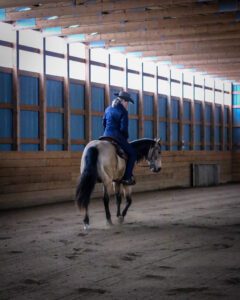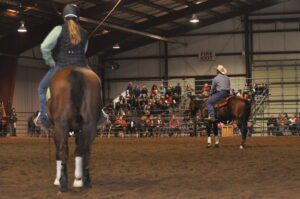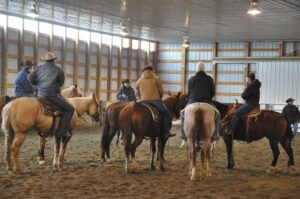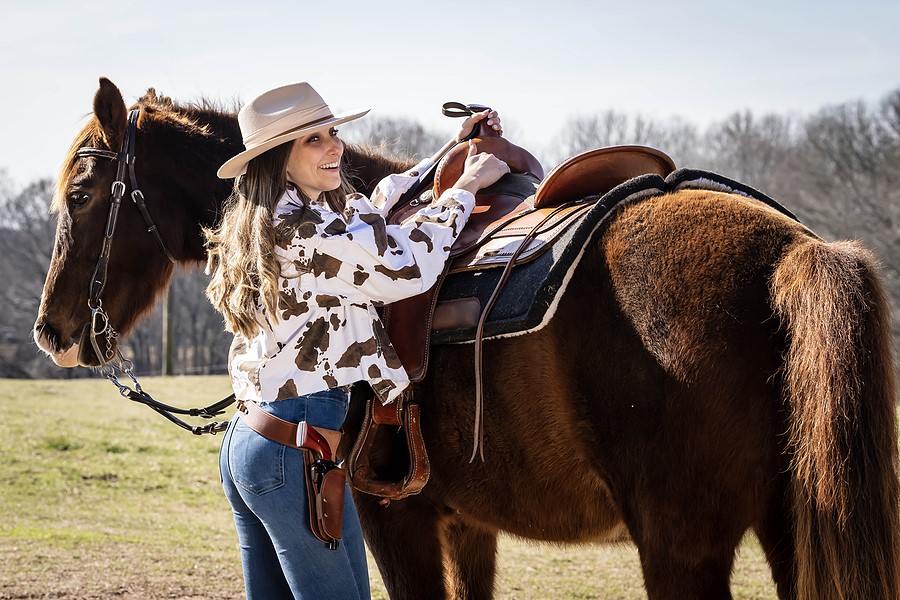Western riding can be difficult, and no matter the experience level, there will always be tips and tricks that you can utilize to help improve your riding technique.
As a general rule, Western requires a combination of balance, coordination, communication, and strength, while implementing consistent practice, and being open to always learning. A special focus should also be placed on your posture and the connection between you and your horse.
The many different disciplines ridden in a Western saddle (the one with the horn), include Western pleasure, reining, cow horse, team penning, cutting, roping, barrel racing, mounted shooting, and a number of other sports not listed here. There is also “Western Riding” which is defined by the American Quarter Horse Association (AQHA) as a class where the horse is judged on its ability to change leads precisely, easily, and simultaneously, using both hind and front legs.
We will be speaking about Western disciplines and riding in terms of the variety of sports – not the single AQHA class.
Western is not easy to master, as with most equestrian sports, and can leave you frustrated and asking:
Will I ever get better at Western Riding?
The main elements involved with mastering Western are practice, dedication, and a desire to always learn and improve. Remember, developing your skills in any sport takes time. Don’t get discouraged if you don’t see immediate improvement. Keep practicing, and you will get better with time.
Develop Your Core Strength
Balance and stability are crucial when riding Western, and these aspects can be greatly improved by working on your core strength. Core strength can be strengthened by working your abdominal muscles through exercises that directly target them, such as planks and crunches.
This can be done using basic at-home exercise equipment such as mats or pull up bars.
You can also indirectly target your core through more advanced exercises like pull-ups and push-ups. These compound exercises will not only improve your core but your overall athletic ability which will not only benefit your riding but your overall quality of life.
Practice Proper Posture
Maintaining a good posture while riding is crucial when it comes to maintaining balance, control, and comfort, and improving performance. At the core of this, a good posture will ensure a rider’s weight is evenly distributed.
How to practice proper posture while riding?
Ensure to sit up straight and with your shoulders back, while keeping your weight evenly distributed over both of the stirrups.
Proper posture will also help you to stay safe, comfortable, and in control while riding.
Use your Legs Correctly
Using your legs correctly when western riding is essential for effective communication with your horse while also maintaining good balance and control.
Your legs should be relaxed, and positioned with your heels down, and toes up while being relaxed on your horse’s sides, and not gripping too tightly. Always be aware of your leg position to ensure that they are ready for each maneuver. For example, depending on how your horse is trained, when you’re asking your horse to turn, your inside leg may need to be slightly behind the cinch to help push your horse’s body in the direction you wish to go.
Master the Basics
The foundation for any skill comes from the basics because, without a solid foundation, you will not have much to build upon.
The essential basics of Western Riding include:
- steering
- stopping
- changing gaits
Once a rider has these basics mastered, it is possible to focus on more advanced maneuvers.
Develop a Strong Seat
Developing a strong seat is necessary to allow a rider to have good balance and maintain control over the horse during different maneuvers like stops, turns, and changes of direction.


Many Western riders will regularly work with cattle or perform ranch work, which makes it essential to have a stable and secure position in the saddle. In addition, a strong seat will prevent the rider from being thrown off balance or being unseated by sudden movements or changes in the horse’s gait. It will also absorb shock and impact when riding through rough terrain or obstacles, consequently reducing the risk of injury to the rider and horse.
Improve Your Timing
Timing is an essential element when it comes to communicating effectively with your horse.


Your timing can be improved in several different ways. Perhaps the most important of these is the practice of transitions and working on your different cues. These two elements work in tandem and can be done by practicing the transition between gaits like walk to jog, lope to stop, and jog to lope. You should place special focus on using your reins, legs, and body position while trying to time your cues with the horse’s movements.
Other elements that can be used to improve your timing include body position, focusing on your horse’s movements, and being receptive to feedback given by peers or coaches.
Build a Partnership with Your Horse
As with any sport that requires you to work with others, having a strong partnership with your teammates will take your skill to the next level. Western is no different in this respect and it is important that you spend sufficient time building up the relationship with your horse using different bonding tips and other groundwork.
Like any other kind of relationship or partnership, the tips remain fairly similar.
- Spend time with your horse
- Work on communication
- Listen to your horse
- Be patient
- Be consistent
- Take care of your horse
By following the above, the partnership with your horse will become stronger, more rewarding and your Western Riding will improve.
Use Your Voice
Your voice is an extremely powerful tool that can often be overlooked when it comes to Western Riding techniques. Your horse identifies and knows you to a large extent through your voice, making it an important skill to master.
Your voice will be used to encourage, praise, or correct your horse, but it should always be used in a calm and controlled manner. Any kind of erratic yelling or shouting can damage the relationship with your horse by startling them and impairing the trust that you have built with them.
Work with a Coach
No matter your experience level, you are never too good to work with a coach to help take your riding to that next level. Even professional sports players like those in the NBA will regularly take 1 on 1 coaching to help identify and refine their weak areas.


A good coach can help you to create an effective training plan which will improve your confidence, riding technique and at the same time, develop your horse’s skills. This can prove especially useful if preparing for a competition, as a coach can help you in everything from grooming, and tack to strategy, and mental preparation.





